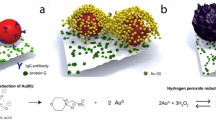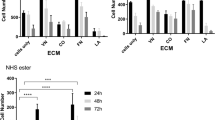Abstract
We have developed a new time-resolved fluorometric (TRF) microarray detection system consisting of fluorescent NH2 nanosphere, TRF microarray detector and gamma-irradiated polystyrene chip. Using the TRF microarray detector, we detected 500 particles of the fluorescent nanosphere in one channel. Cross-talk fluorescence from the adjacent channels was little observed in the TRF microarray detector (<0.0004 %). The TRF microarray detection system was further applied for serum allergen-specific immunoglobulin E (IgE) multi-analyses. As a labeled tag antibody, an anti-human IgE Fab’ fragment-conjugated fluorescent nanosphere (Fab’ nanosphere) was prepared as described previously. As a chip surface appropriate for allergen immobilization, the polystyrene chip surface was modified by gamma irradiation. The immunoassay reactivity using the gamma-irradiated polystyrene chip was approximately 2.5-times improved compared with that of the non-treated polystyrene chip. Non-specific adsorption of the Fab’ nanosphere onto the gamma-irradiated polystyrene chip surface was very low level (<0.0009 %). In only 20 μl of serum, six allergen-specific IgEs could be simultaneously determined in one reaction well in fewer than 90 min. Good correlation curves were obtained between the microarray immunoassay and the CAP RAST fluoro-enzyme immunoassay (CAP/RAST FEIA) method (r>0.961). Reproducibility (CVs) of the microarray immunoassay was 8.6 % to 19.0 % (n=5).






Similar content being viewed by others
References
Barinaga MW (1991) Science 253:1489
Kim JH, Kim HY, Lee YS (2001) Exp Mol Med 33:83–88
Lueking A, Horn M, Eickhoff H, Bussow K, Lehrach H, Walter G (1999) Anal Biochem 270:103–111
MacBeath G, Schreiber SL (2000) Science 289:1760–1763
Joos TO, Schrenk M, Hopfl P, Kroger K, Chowdhury U, Stoll D, Schorner D, Durr M, Herick K, Rupp S, Sohn K, Hammerle H (2000) Electrophoresis 21:2641–2650
Robinson WH, DiGennaro C, Hueber W, Haab BB, Kamachi M, Dean EJ, Fournel S, Fong D, Genovese MC, de Vegvar HE et al (2002) Nat Med 8:295–301
Mezzasoma L, Bacarese-Hamilton T, DiCristina M, Rossi R, Bistoni F, Crisanti A (2002) Clin Chem 48:121–130
Hiller R, Laffer S, Harwanegg C, Huber M, Schmidt WM, Twardosz A, Barletta B, Becker K, Breiteneder H, Chapman M et al (2002) FASEB J 16:414–416
Schweitzer B, Wiltshire S, Lambert J, O'Malley S, Kukanskis K, Zhu Z, Kingsmore SF, Lizardi PM, Ward DC (2002) Proc Natl Acad Sci U S A 97:10113–10119
Kim TE, Park SW, Cho NY, Choi SY, Yong TS, Nahm BH, Lee S, Noh G (2002) Exp Mol Med 34:152–158
Aveseenko NV, Morozova TY, Ataullakhanov FI, Morozov VN (2002) Anal Chem 74:927–933
Suck R, Nandy A, Weber B, Stock M, Fiebig H, Cromwell O (2002) Allergy 57:821–824
Jahn-Schmid B, Harwagegg C, Hiller R, Bohle B, Ebner C, Scheiner O, Mueller MW (2003) Clin Exp Allergy 33:1443–1449
Fall BI, Eberlein-König B, Behrendt H, Niessner R, Ring J, Weller MG (2003) Anal Chem 75:556–562
Matsuya T, Tashiro S, Hoshino N, Shibata N, Nagasaki Y, Kataoka K (2003) Anal Chem 75:6124–6132
Härmä H, Soukka T, Lövgren T (2001) Clin Chem 47:561–568
Soukka T, Paukkunen J, Härmä H, Lönnberg S, Lindroos H, Lövgren T (2001) Clin Chem 47:1269–1278
Scorilas A, Bjartell A, Lilja H, Moller C, Diamandis EP (2000) Clin Chem 46:1450–1455
Luo LY, Diamandis EP (2000) Luminescence 15:409–413
Ogawa R, Nagasaki Y, Shibata N, Otsuka H, Kataoka K (2002) Polymer J 12:868–875
Hoshino N, Hama M, Suzuki R, Kataoka Y, Soe G (1985) J Biochem 97:113–118
Vieths S, Schöning B, Petersen A (1994) Int Arch Allergy Immunol 104:399–404
Product information of Nalge Nunc International KK
Bousquet J, Chanez P, Chanal I, Michel FB (1990) J Allergy Clin Immunol 85:1039–1043
Pharmacia CAP system—specific IgE FEIA, directions for use, April 1992, revised February 2000, Pharmacia & Upjohn Diagnostics AB, Uppsala, Sweden
Acknowledgments
The authors wish to thank Mr. I. Shindo, for his advice on the construction of the TRF microarray detector, and the Corona Electric Co., Ltd., for construction of the TRF microarray detector. The present work was financially supported by the New Energy and Industrial Technology Development Organization (NEDO).
Author information
Authors and Affiliations
Corresponding author
Rights and permissions
About this article
Cite this article
Matsuya, T., Otake, K., Tashiro, S. et al. A new time-resolved fluorometric microarray detection system using core–shell-type fluorescent nanosphere and its application to allergen microarray. Anal Bioanal Chem 385, 797–806 (2006). https://doi.org/10.1007/s00216-006-0455-9
Received:
Revised:
Accepted:
Published:
Issue Date:
DOI: https://doi.org/10.1007/s00216-006-0455-9




